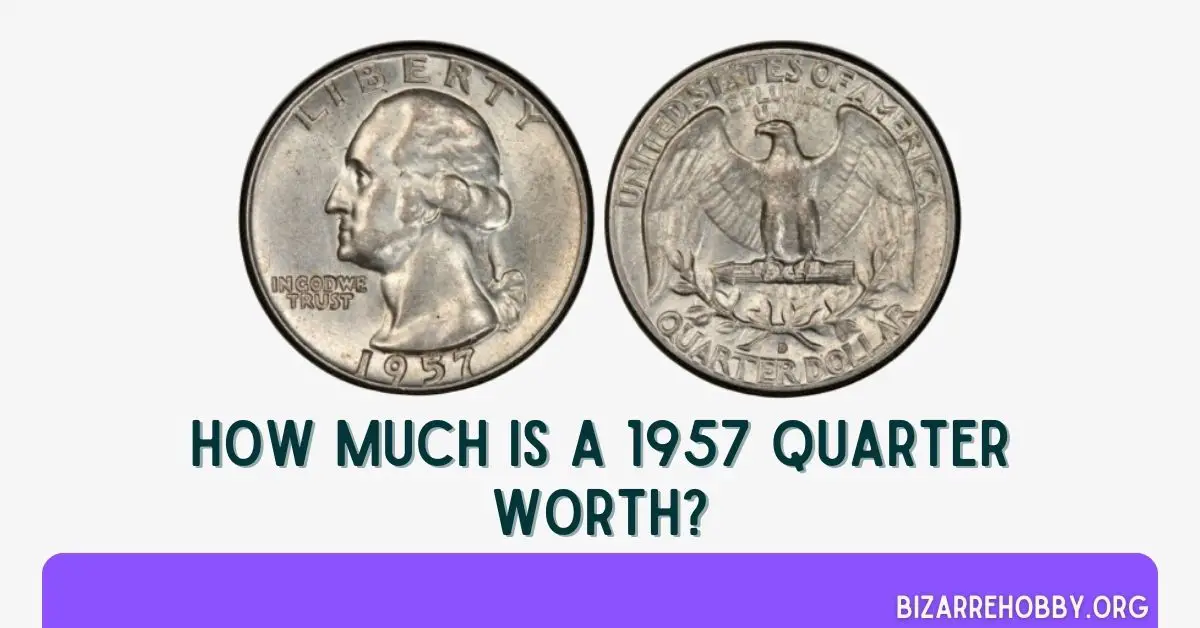Are you the proud owner of a 1957 Washington quarter, wondering about its potential worth? Perhaps you’re a coin enthusiast looking to add this specific piece to complete your Washington series collection? Whatever your situation, you’ve come to the right place for answers!
Washington quarter dollars hold a special place in numismatics, cherished for both their historical significance and sentimental value. These coins serve as miniature tributes to George Washington, the first President of the United States, making them highly sought after by collectors eager to preserve a tangible piece of American history.
This comprehensive guide aims to shed light on the true value of the 1957 quarter, helping you understand just how much your silver coin might be worth in today’s market. Whether you’re a seasoned collector or new to the world of coin collecting, this information will prove invaluable.
By the end of this guide, you’ll have a clear understanding of the factors influencing your 1957 quarter’s worth and be better equipped to assess its value accurately.
So, let’s embark on this numismatic journey and answer the burning question: just how much is a 1957 quarter worth in today’s market?
1957 Quarter Value Chart
| Mint Mark | Good | Fine | Extremely Fine | Uncirculated |
|---|---|---|---|---|
| 1957 No-Mint Mark Quarter Value | $9.72 | $9.72 | $9.72 | $13 |
| 1957-D Quarter Value | $9.72 | $9.72 | $9.72 | $13 |
| 1957 Proof Quarter Value | – | – | – | $150 |
History Of The 1957 Quarter
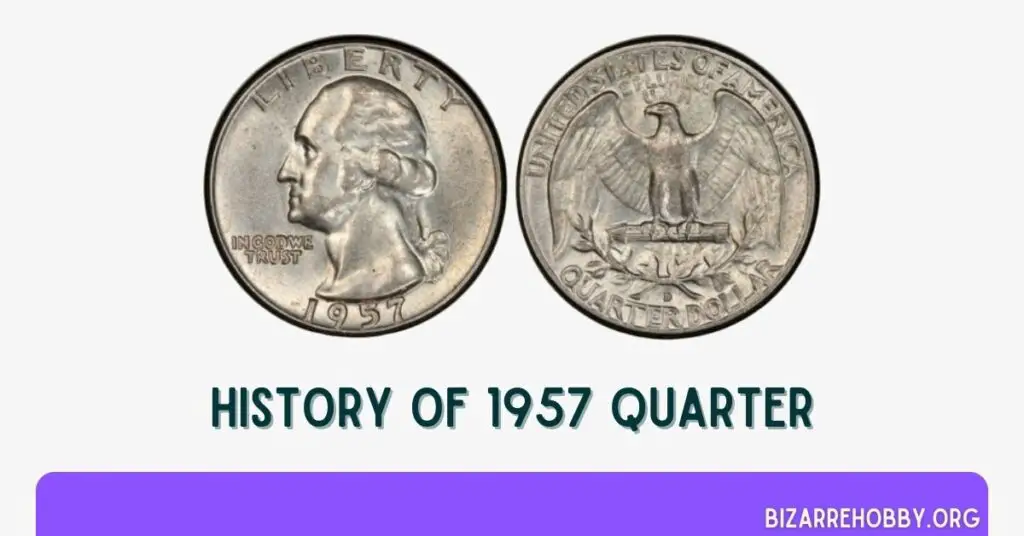
The 1957 quarter is a part of the esteemed Washington quarter dollar series, which began in 1932 to honor the 200th anniversary of George Washington’s birth. This coin series has since become one of the longest-running in American numismatic history.
The journey to create this iconic coin started nearly a decade before its introduction. In 1924, Congress established a Bicentennial Commission to plan the celebrations, including the creation of a new coin. However, this initial group became inactive, leading to the formation of a new Commission in 1930 to oversee the commemorative efforts.
Initially, the Commission proposed replacing the Walking Liberty half dollar with the new Washington coin. Congress, however, favored replacing the Standing Liberty Quarter instead. This decision, though not unanimously embraced, set the stage for the Washington quarter’s creation.
The Commission initially favored Lauren Gardin Fraser, an experienced coin designer, for the project. However, the Treasury decided to hold an open competition to select the designer, departing from the Commission’s recommendation.
Ultimately, the Mint and Treasury selected John Flanagan to create both the obverse and reverse designs. Flanagan drew inspiration from a 1785 Washington portrait by renowned sculptor Jean-Antoine Houdon, capturing the essence of America’s first president in his design.
The first Washington Quarters were struck in early July 1932 and began circulating by August of the same year. From 1932 to 1964, these quarters were minted using silver. However, rising silver prices in 1964 prompted the Mint to transition to copper-clad composition for subsequent issues.
Washington quarters, including those minted in 1957, are highly sought after by collectors, especially in uncirculated condition. Despite being part of a long-running series, these coins maintain their appeal in numismatic circles.
The 1957 quarter, in particular, represents a significant year in American history. It was minted during the height of the Cold War and the Space Race, adding historical context to its numismatic value.
In the following sections, we’ll explore the unique features of the 1957 quarter and factors that influence its value in today’s collector’s market.
Features Of The 1957 Quarter
Understanding the unique characteristics of the 1957 quarter is crucial for collectors and enthusiasts alike. This knowledge will help you identify valuable specimens and appreciate the coin’s historical significance.
Obverse Design of 1957 quarter

The obverse of the 1957 quarter showcases a dignified left-facing portrait of George Washington, America’s first president. Key elements include:
- Washington’s profile with hair tied back in a low ponytail
- “LIBERTY” inscribed prominently along the top edge
- The national motto “IN GOD WE TRUST” on the left side
- The year “1957” at the bottom
This design, created by John Flanagan, has remained largely unchanged since the quarter’s introduction in 1932, emphasizing continuity in American coinage.
Reverse Design of 1957 Quarter
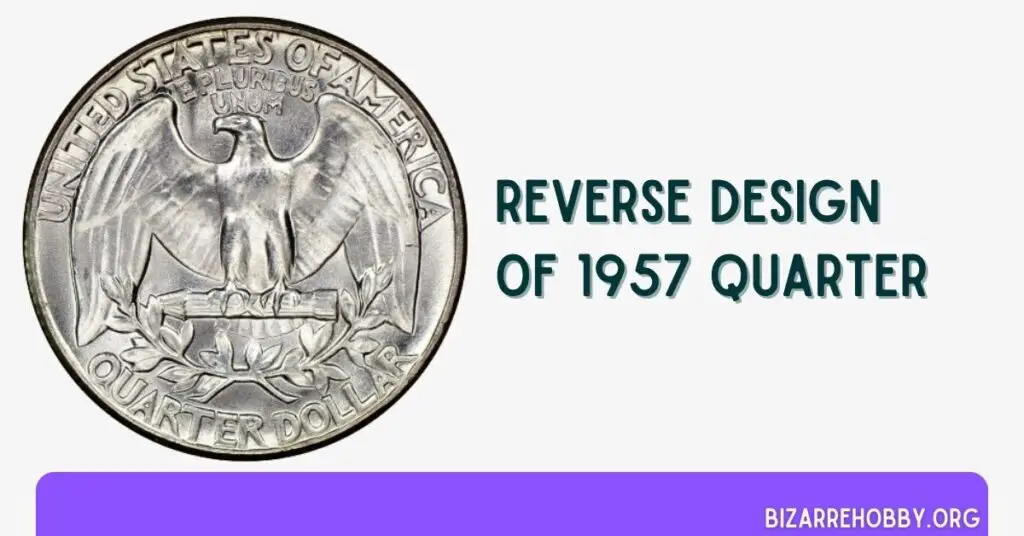
The reverse side presents a more intricate design, rich with national symbolism:
- A left-facing bald eagle with wings spread wide.
- The eagle perched on a bundle of arrows, symbolizing strength and readiness.
- Two olive branches tied together below, representing peace.
- “UNITED STATES OF AMERICA” inscribed along the top edge.
- The Latin motto “E PLURIBUS UNUM” (“Out of many, one”) below.
- “QUARTER DOLLAR” denomination at the bottom.
This combination of elements represents the balance between peace and strength in American ideals.
Technical Specifications of 1957 Quarter
- Composition: 90% silver, 10% copper
- Diameter: 24.30 millimeters
- Weight: 6.30 grams
- Edge: Reeded
The silver content adds intrinsic value to the coin beyond its face value and collectible status.
Mint Marks and Production of 1957 Quarter
Two mints produced the 1957 quarter:
- Philadelphia Mint: No mint mark on either regular strikes or proofs
- Denver Mint: Identified by a “D” mint mark on the obverse, near Washington’s ponytail
This information is crucial for collectors, as mint marks can significantly affect a coin’s value.
Understanding these features will help you appreciate the craftsmanship of the 1957 quarter and potentially identify valuable specimens in your collection. In the next section, we’ll explore how these characteristics, along with the coin’s condition, influence its overall value in today’s market.
Grading Your 1957 Quarter
Accurately grading your 1957 quarter is essential to determine its true value. Silver Washington quarters, including those from 1957, are susceptible to wear due to silver’s softness. Here’s a guide to help you assess your coin’s condition.
Key areas to examine
| Obverse (Front) | Reverse (Back) |
|---|---|
| Hair curls around Washington’s ear | Front of the eagle’s legs and feathers |
| Top of Washington’s hair | Edge of the eagle’s wings |
| Washington’s cheeks | – |
Uncirculated coins should retain full, complete luster in these areas. Any signs of wear, dullness, or smoothness indicate circulation. Remember to use a single light source for examination and look for any loss of detail in high-relief areas. Also don’t forget to check for signs of wear or smoothing on raised surfaces.
| Grade Number | Grade |
|---|---|
| 1 | Basal State-1 |
| 2 | Fair |
| 3 | Very Fair |
| 4, 5, 6 | Good |
| 7, 8, 10 | Very Good |
| 12, 15 | Fine |
| 20, 30 | Very Fine |
| 40 | Extremely Fine |
| 50 | About Uncirculated |
| 60 | Mint State |
| 65 | Mint State |
| 70 | Mint State |
For precise grading, please refer to our professional Washington quarter grading guide or consider having your coin evaluated by a numismatic expert.
1957 Quarter Value Guide
The value of a 1957 quarter can vary significantly based on several factors:
- Condition (grade)
- Mint mark
- Presence of minting errors
- Overall rarity
There are three main varieties of the 1957 quarter:
- 1957 No-Mint Mark Quarter (Philadelphia)
- 1957-D Quarter (Denver)
- 1957 Proof Quarter (Philadelphia)
Each of these varieties can have different values depending on their condition and any unique characteristics. In the following sections, we’ll break down the potential values for each type of 1957 quarter, helping you understand what your coin might be worth in today’s collector’s market.
Remember, rare minting errors or exceptionally high-grade specimens can command premium prices above standard valuations. Always consult current price guides or professional appraisers for the most accurate and up-to-date valuations.
1957 No-Mint Mark Quarter Value and Rarity

The Philadelphia Mint, which produced quarters without a mint mark, struck approximately 46,532,000 Washington quarters in 1957. This substantial mintage offers some interesting characteristics and value propositions for collectors.
1957 was a year of notable production challenges for the Philadelphia Mint:
- Continued use of worn or re-polished dies from 1956
- Attempts to improve quality by using proof dies from the previous year
- Resulting coins often have a dull obverse with poor strike quality
- Reverse sides tend to be brighter with sharper details due to the use of proof dies
Here are some general 1957 no-mint mark quarter value range:
- Circulated Specimens: Generally affordable, ranging from $4.35 to $9.72.
- Uncirculated Specimens: The MS63 grade goes for around $14 whereas the MS67 grade goes for up to $125 (very rare in this condition).
The significant price jump for higher grades is due to the scarcity of gem-quality examples, given the poor strike quality of this year’s production.
Gem-quality 1957 no-mint mark quarters (MS67 and above) are extremely rare and highly valued by collectors. The most expensive known sale of this variety was:
- Grade: MS68
- Sale Price: $3,819
- Auction: Heritage Auctions, 2012
This record sale underscores the potential value of exceptionally well-preserved specimens from this year.
If you come across a high-grade 1957 no-mint mark quarter (MS67 or above), it could be a valuable find. These coins represent a unique intersection of historical mint practices and numismatic rarity, making them particularly interesting to collectors focused on mint state coins or those completing high-grade sets of Washington quarters.
Remember, professional grading is crucial for accurately determining the value of high-grade specimens, as the difference between grades can significantly impact the coin’s worth.
1957-D Quarter Value

The Denver Mint produced an impressive 77,924,160 Washington quarters in 1957, marking the highest mintage in the series since 1944. This high production volume, combined with generally better strike quality, makes the 1957-D quarter an interesting subject for collectors.
Here are some production qualities of 1957-D quarter value:
- Generally better struck than their Philadelphia counterparts.
- Gem-quality specimens (MS67 and above) are more readily available.
- Many high-grade examples come from previously hoarded rolls.
Here is the 1957-D Quarter value range:
| Circulated Specimens | Uncirculated Specimens |
|---|---|
| Worth between $4.35 and $6.75. | MS67 grade can sell for up to $275 |
| While not extremely valuable, these coins are worth significantly more than face value, making them collectible. | Higher grades can command even more substantial premiums |
The most notable sale of a 1957-D quarter occurred in 2021:
- Grade: MS68
- Sale Price: $11,400
- Auction: Stack’s Bowers
- Certified by: Professional Coin Grading Service (PCGS)
This record-breaking sale demonstrates the potential value of exceptionally well-preserved specimens, even from a year with high mintage.
The 1957-D quarter presents an interesting opportunity for collectors:
- High mintage means examples are readily available for those building complete sets
- Better overall strike quality increases the chances of finding high-grade specimens
- The significant price difference between circulated and top-grade uncirculated coins offers potential for value appreciation
For collectors, the challenge lies in finding the best-preserved examples. While MS67 coins are more common than in the Philadelphia mintage, the jump in value to MS68 is substantial, reflecting the rarity of coins in pristine condition.
When evaluating 1957-D quarters, pay close attention to the overall luster, strike quality, and preservation of details, particularly on high points like Washington’s hair and the eagle’s feathers. As always, professional grading is recommended for coins suspected of being in the highest grades, as small differences can have a significant impact on value.
1957 Proof Quarter Value

The Philadelphia Mint, in addition to its standard coin production, created proof coins for collectors in 1957. That year saw an unprecedented output of 1,247,952 proof quarters, a volume that inadvertently compromised the quality of the coins. This surge in production was a response to excessive demand following the 1956 proof set speculation boom, leading collectors to over-order in anticipation of potential shortages.
Typically, proof coins are characterized by their superior strike, brilliant luster, and exceptional visual appeal. However, the 1957 proof quarters often fell short of these standards. Many exhibited signs of worn or over-polished dies, resulting in coins with diminished detail and reduced contrast between the raised design elements and the flat background areas.
The unexpectedly large mintage caught speculators off guard, triggering a market collapse and a significant decrease in the value of 1957 proof quarters. This event serves as a cautionary tale about the risks of speculative collecting and the impact of supply and demand on numismatic markets.
While fully brilliant proofs are relatively common up to the PF69 grade, deep cameo specimens from this year are exceedingly rare. The scarcity of these high-contrast examples makes them highly sought after by serious collectors.
In terms of current market value, an average 1957 proof quarter is valued at approximately $150. However, the rare deep cameo variants can command substantially higher prices. For instance, a PF69DCAM (Proof 69 Deep Cameo) specimen sold for an impressive $11,400 at a Stack’s Bowers auction in 2023, highlighting the premium placed on exceptional quality and rarity.
Despite their production issues, 1957 proof quarters remain popular among collectors, particularly those focusing on completing Washington quarter sets from the 1950s.
These coins offer value beyond their face amount and silver content, making them an attractive option for novice collectors with limited budgets who are looking to enter the numismatic market. Their historical significance and potential for appreciation make them a noteworthy addition to any coin collection.
Rare 1957 Quarter Errors List
The immense production of over 125 million quarters in 1957 by the Denver and Philadelphia Mints inevitably led to various minting errors. While most 1957 quarters are not particularly valuable, the presence of interesting errors can significantly enhance a coin’s worth. Let’s explore some of the most noteworthy and valuable 1957 quarter errors.
1957 Misplaced Mint Mark Quarter Error
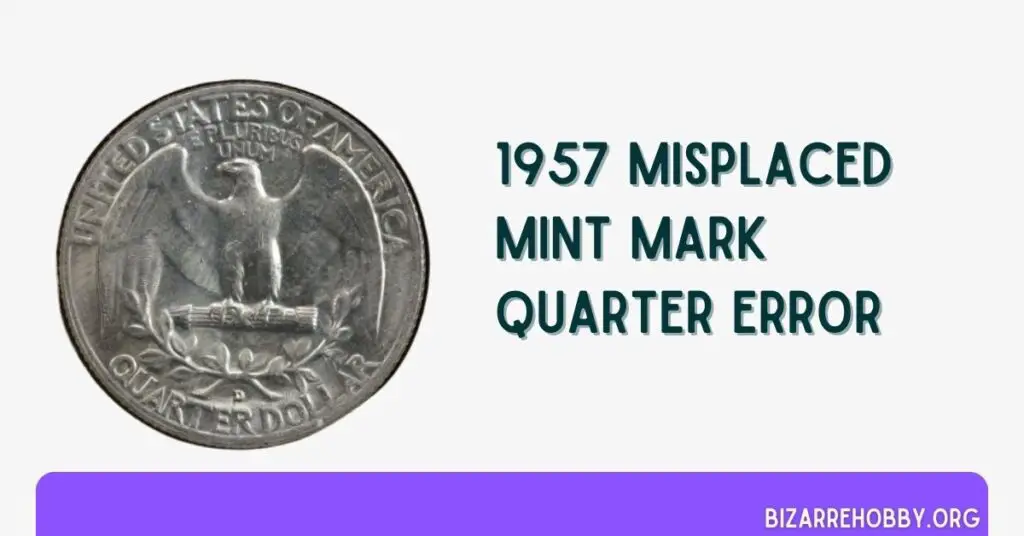
Mint mark errors are relatively uncommon, as mint employees typically exercise great care in properly positioning these important identifiers. On standard 1957 Denver quarters, the ‘D’ mint mark should appear on the reverse side, precisely between the ‘E’ and ‘R’ in “QUARTER DOLLAR.” However, some 1957 quarters exhibit a slightly misaligned mint mark, with the ‘D’ shifted closer to the ‘R’.
This subtle misplacement can significantly increase the coin’s value. Depending on the overall condition of the quarter, collectors might pay between $200 and $270 for a misplaced mint mark error from this year.
1957 Re-Punched Mint Mark Quarter Error
A re-punched mint mark error occurs when the die used to imprint the mint mark strikes multiple times, resulting in a visibly doubled or partially filled-in mint mark. This type of error is more common in high-mintage series like the 1957 quarters.
Numismatists and error coin enthusiasts are often willing to pay a premium for such pieces, with prices reaching up to $75 for a well-preserved 1957 re-punched mint mark error quarter.
1957 Type B Reverse Proof Strike Error
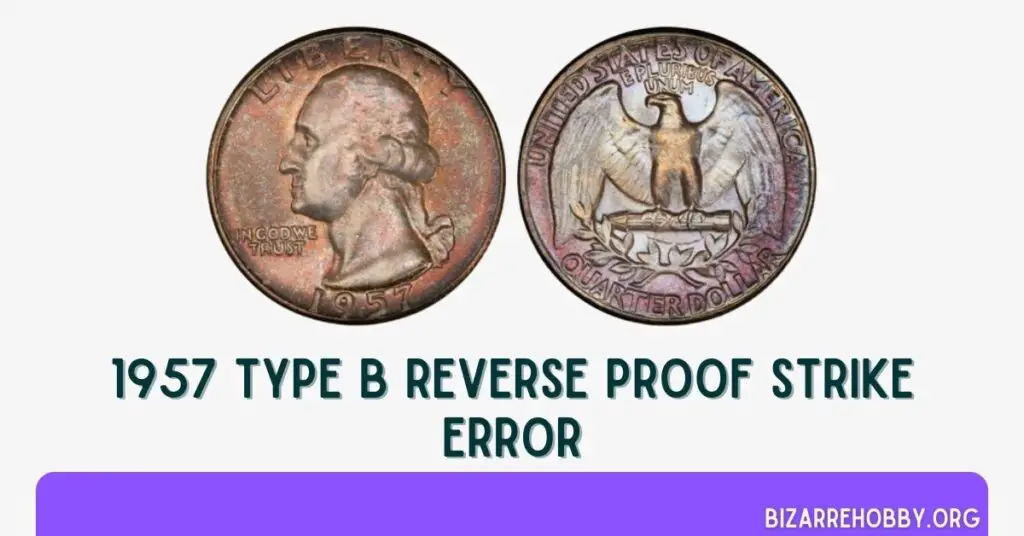
The Type B reverse proof strike error is the most frequently encountered anomaly in the 1957 Washington quarter series. This error resulted from an unusual minting process where the obverse (front) of the coin was struck with regular production dies, while the reverse (back) was struck using proof dies.
It’s speculated that this error may have occurred due to the deteriorating condition of regular production dies at the Philadelphia Mint, forcing workers to utilize proof dies as a temporary solution. This mix-up in die usage created a unique hybrid coin with distinct characteristics on each side.
Given its intriguing nature and the insight it provides into mint operations, the Type B reverse proof strike error is highly valued by collectors. Well-preserved examples of this error can command prices of $200 or more, making it a sought-after variety in the 1957 quarter series.
These error coins not only offer monetary value but also provide fascinating glimpses into the minting process and its occasional imperfections, making them prized additions to any numismatic collection focused on American coinage or error varieties.
Where To Sell Your 1957 Quarter?
If you’ve determined the value of your 1957 quarters and are considering selling them, you might be wondering about the best platforms for online coin sales. To assist you, I’ve compiled a list of reputable online marketplaces, complete with introductions, advantages, and potential drawbacks for each.
For a comprehensive guide, please refer to: Top Online Platforms for Coin Sales: A Comparative Analysis
FAQs on 1957 Quarter Value
Is A 1957 Quarter Made Out Of Silver?
Indeed, all Washington quarters minted before 1964, including those from 1957, contain 90% silver and 10% copper. However, it’s important to note that melting these coins for their silver content is generally discouraged due to their numismatic value and historical significance.
What Is Special About The 1957 Quarter?
While the 1957 quarter doesn’t possess any particularly unique features, it is notable for having the highest mintage in the Washington quarter series since 1944. As a result, these quarters are quite common across all grade levels, making them readily available to collectors but potentially less valuable than rarer issues.
How Much Does A 1957 Silver Quarter Weigh?
A 1957 quarter has a substantial feel, weighing approximately 6.25 grams (not 6.35 as originally stated) and measuring 24.3 millimeters in diameter. The coin’s silver content contributes significantly to its weight, giving it a heft that distinguishes it from modern clad quarters.
